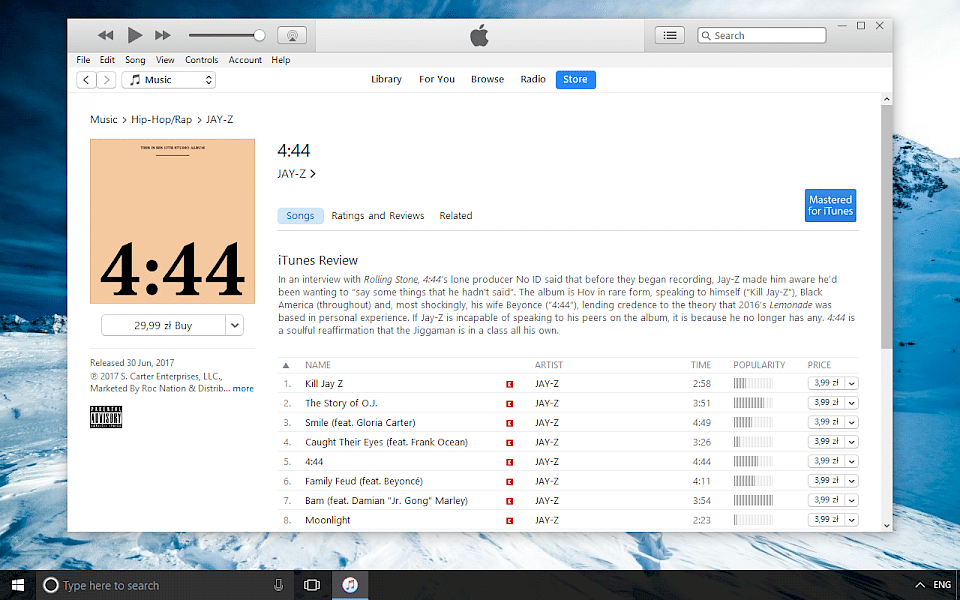
- #NO SOUND FROM ITUNES WINDOWS 10 HOW TO#
- #NO SOUND FROM ITUNES WINDOWS 10 INSTALL#
- #NO SOUND FROM ITUNES WINDOWS 10 DRIVERS#
- #NO SOUND FROM ITUNES WINDOWS 10 DRIVER#
- #NO SOUND FROM ITUNES WINDOWS 10 LICENSE#
'There was a problem with updating database to the newest version' error message. #NO SOUND FROM ITUNES WINDOWS 10 INSTALL#
Can't Install Upgrade / Uninstall (error code 5). UAC or COM Elevator Prompt appears each time MediaMonkey for Windows starts. Modifying the MediaMonkey database and settings files / changing the default database location. MediaMonkey Database or Settings are lost. What operating systems is MediaMonkey compatible with?. #NO SOUND FROM ITUNES WINDOWS 10 LICENSE#
Can I Use a Gold License on Multiple Machines?. Upgrade from earlier versions of MediaMonkey. #NO SOUND FROM ITUNES WINDOWS 10 HOW TO#
How to use a Gold License Key (it's not working)?. What's a 'Free' vs 'Gold' (5.x vs Lifetime) License?. If MediaMonkey is freeware, why isn't MP3 encoding unlimited?. If there is no sound in videos make sure the correct Audio Device has been selected in the MediaMonkey Video Player Input Plugin under Tools > Options > Input Plug-ins from the Main Menu. Make sure you disable the option ‘Only analyze files with unknown Leveling Adjustment’ under Tools > Options > Volume Leveling from the Main Menu. Re-analyze the volume, using Tools > Analyze Volume from the Main Menu, of the affected files. If you experience playback distortion for files purchased from Amazon you’ll need to Analyze their Volume again as the Volume values may be incorrect. Kernel Streaming (MediaMonkey 4 only):. ASIO: Compatibility with ASIO-Capable Sound Cards. If the above doesn’t work, you can try a number of alternative output plugins:. If the WASAPI plugin yields static and clicks, or no sound, try alternative configurations. Switching from ‘Primary Sound Driver’ to the specific Audio Device on your PC. Go to Tools > Options > Output Plug-ins from the Main Menu, select the DirectSound plugin and click Configure. If the DirectSound plugin yields static, you can try reconfiguring it. Go to Tools > Options > Output Plug-ins from the Main Menu in MediaMonkey and change from WASAPI to DirectSound/WaveOut output or the other way around from DirectSound/WaveOut to WASAPI. #NO SOUND FROM ITUNES WINDOWS 10 DRIVER#
Select the correct Audio Device on your PC (generally Primary Sound Driver will work). Go to Tools > Options > Output Plug-ins from the Main Menu in MediaMonkey and select the enabled Output Plug-in and click Configure.
If you recently performed an upgrade to your audio drivers, you may need to re-register them in MediaMonkey. #NO SOUND FROM ITUNES WINDOWS 10 DRIVERS#
This can be related to underlying audio drivers and how the interact with your system. Check for driver downloads with the hardware provider. realtek), and it needs to be updated/re-installed.
There’s a problem with your sound driver (e.g. Use Start > Settings > System > Sound to configure what output device Windows will use. Windows is set to use the wrong Audio Device. The headphone or speakers are disconnected. If no sound plays and/or the sound is corrupted for all apps, it can be that: Try playing audio via Windows Media Player, Groove, or any other application. The MediaMonkey App Volume is set to 0 in Windows. Type App Volume in Windows Start to access these settings or right click on the Speaker Icon (next to clock in Windows Task Bar) > Open Volume Mixer > Adjust volume of MediaMonkey. There are 2 volume settings in Windows that can mute MediaMonkey. Select the correct Audio Device on your PC (generally Primary Sound Driver/Default device will work). Go to Tools > Options > Output Plug-ins from the Main Menu and select the enabled Output Plug-in and click Configure. MediaMonkey is set to use the incorrect Audio Device on your PC. On MediaMonkey 4 and older use Tools > Options > Player from the Main Menu to set it to the MediaMonkey Player. On MediaMonkey 5 use Tools > Options > Streaming from the Main Menu to change Play To Internal Player. a UPnP player) that is set to low volume or is unavailable. The Player has been set to output to a different device (e.g. If the Player doesn’t feature a volume slider right click on the MediaMonkey tray icon in the Windows Taskbar tray (next to clock) and select Volume > 100%. 
Verify that the MediaMonkey volume slider is set correctly (if you don’t see the Player, click View > Player). If attempts to play all content result in silence or corruption (but files aren’t greyed out), the problem can be at any of steps 3-6 to diagnose the problem, first disable the equalizer & DSP plugins (via Tools > Options > Player > DSP Plugins), and Volume Leveling (via Play > Level Playback Volume). If playback issues only occur with certain files, see Why is Music Greyed Out / Fails to Play? This article discusses issues that may occur at step 6 such output-related problems will typically just result in silence or audio corruption– the tracks are usually not greyed out and the problem will occur with all audio files/formats.
 Sound is output via the Output plug-in. Audio file is decoded by input plug-in.
Sound is output via the Output plug-in. Audio file is decoded by input plug-in. 
MediaMonkey Sound is generated as follows:







 0 kommentar(er)
0 kommentar(er)
